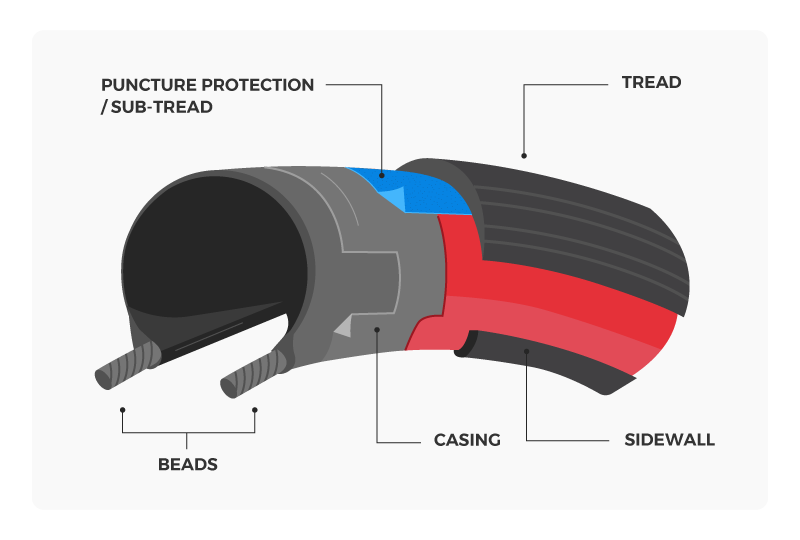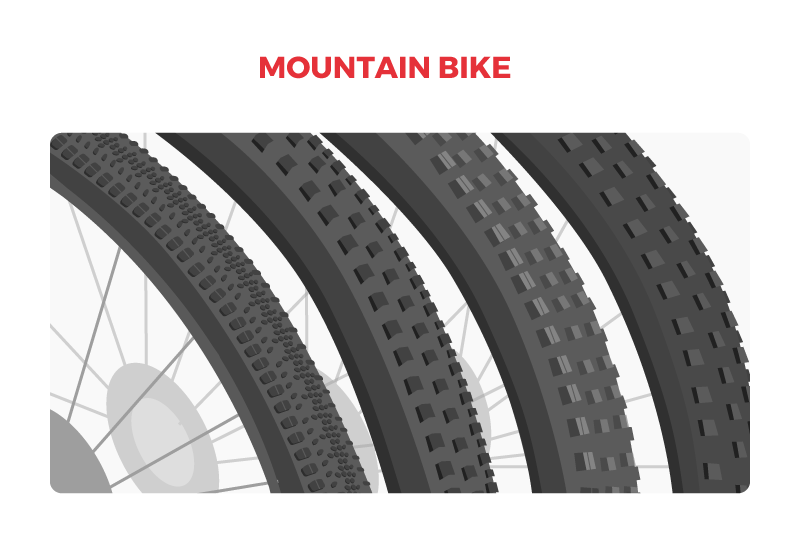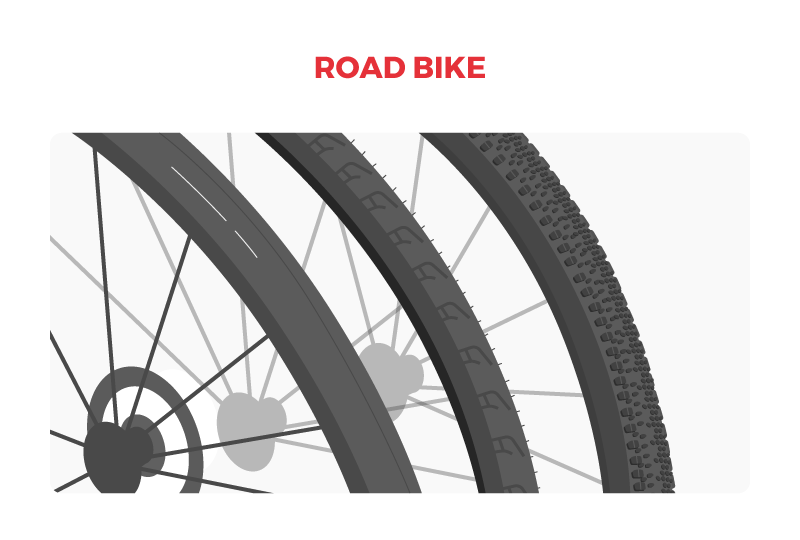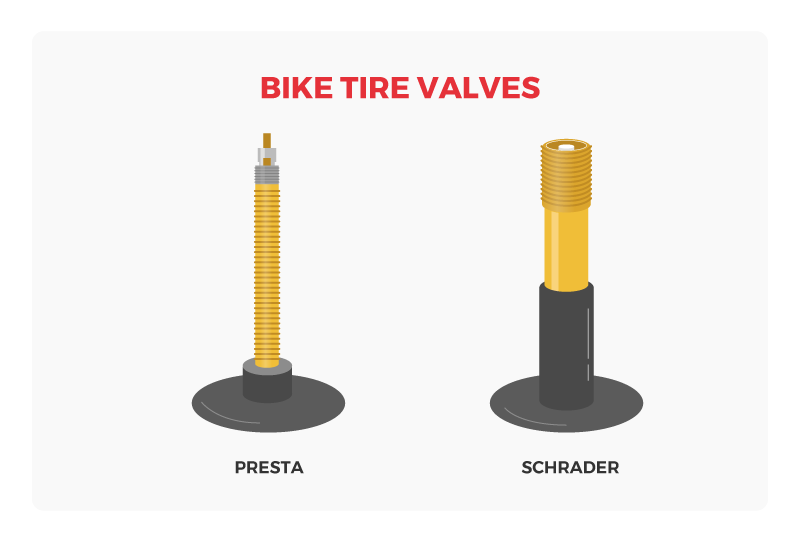Discovering new things about a hobby we love is a spectacular feeling. Bicycles have a lot of parts, and I mean a lot. Tires are a big part of what makes a bicycle roll, and it is possible to learn all about bike tires just like you learned about the other parts of bicycles. You just have to be curious enough to keep wanting to read more.
In this article, we are going to cover a bit about bike tires, and then we’ll discuss the different types of tires out there. Can’t wait? Read more to learn today.
Table of Contents
A Bike Tire
Before we go into the different types of bike tires out there, it would be best to first know more about bike tires themselves.
A bike tire is made of different parts:

Each part serves their own purposes, and all their purposes are important to keep the air in and keep you rolling comfortably.
The beads on the tire are responsible for holding the tire onto the rim. These are commonly found on clincher and tubeless tires. A tubular tire doesn’t need a bead to hold on to the rim.
The casing is what holds the beads together. It is responsible to keep air from breaking out as you pedal on the road. Casings are measured in TPI, or threads per inch, this is what also protects you from getting a puncture in the road. TPI is responsible for the various amounts of rolling resistance riders feel.
A tire also has extra puncture protection. It’s a sub thread that acts as a puncture proof belt and gives your tires extra strength. It can be made of different things, depending on the tire you use. It could be rubber, or other compounds that are ultimately meant to give you additional security.
The sides of the tire are called the sidewalls. Some tire brands and models also feature puncture protection in the sidewall, but not all do. This is the part of the tire that will not touch the ground, but it’s still responsible for keeping air in. Gravel or mountain tires usually have more protection in the sidewalls compared to road tires.
Manufacturers print information about the tire in the sidewall.
Thread is the outermost layer of a tire. It’s the part of the tire that will touch the ground. It can be made of several materials and has many patterns – tread patterns. It all depends on the purpose of the tire, and what kind of bike it will pair with.
How To Choose A Bike Tire
After learning about the bike tire itself, know that there are a lot of different types out there. Most are already specific to the use. E.g, there are road bike tires for road bikes, and mountain bike tires for mountain bikes.
But how can you even begin to find the best? Well, the trick is learning more about the different types of tires out there.
The size, tread, and rolling resistance is a great start for you to be more familiar with all the different options available. While you’re on the topic and learning, you should also read about tire valves. Although, valves will affect maintenance more than it will affect your riding experience.
Bike Tires Sizes
This is the most important trait of a bicycle. Bike tires come in all kinds of different sizes. Mountain bike tires come in more sizes than road bikes. This has to do with the terrain. You don’t have too many varieties during road riding, but you do have a lot of different grounds during mountain riding.
As for the measurement, they do it universally. You get the tire diameter by measuring from both outer ends of the tire. And you can get the width size by measuring the distance of the tire’s outside walls.
The outer diameter of a mountain bike tire can be 26 inches, 27.5 inches, or even 29 inches.
The width measures 1.9 inches up to 5 inches. It depends on whether you’re doing cross-country biking, trailing, or if you prefer downhill routes.
Road bike tires measure 700 mm outer diameter. And its width starts from around 22 mm up to 45 mm.
For kid’s bikes, they are only around 20 inches up to 24 inches in diameter.
If you’re still confused about bike tire sizing, you can read it on the sidewall. So the first number is the rim diameter in mm, and the second number is the tire diameter.
These different sizes will contribute to the comfort, performance, and durability you get.
There was a time when people favored thinner tires filled with high pressure. They thought it meant your bike can roll faster.
Now, it has been found that larger tires are more comfortable, and they offer more traction. Besides that, they also offer less rolling resistance, which is what you want.
A bigger tire will give you more speed because there will be less tension and resistance from the sidewalls.
It is more ideal for thinner tires to be used on smoother roads, and for wider tires to be used on bumpy roads. With all that information in mind, it’s up to you to find the best tire that will serve your needs better.
A great tire for one person may not be the best option for another, and that’s why it’s important to learn and not just ask for the best tire.
Bike Tires Thread
Threads have just as much of an impact on your ride as the tire size. You need to consider your terrain for this to work.
The tire thread is made from butyl rubber and other materials that will protect you against puncture. The material is also responsible for providing you with that grip on the road. And it can also come in a pleasant color, but that’s not important right now.
An important thing is what the tire thread does. They give you your desired amount of rolling resistance.
So again, it comes down to the type of road you’re on. That’s why mountain bikes and road bikes have very different thread patterns.
Mountain bikes are knobbier while road bikes are more slick. See for yourself.

Mountain bike tires offer more variety of thread patterns, just like their sizes. Again, this is because of the many different roads a mountain bike can take on. There’s also the different weather conditions, dry, wet, snowy, and so on.
You can combine and match if you know how. But before all that, you need to know which is meant for what roads.
If you ride in dryer condition, you will feel great with a semi slick thread with knobs on the sidewalls to help you tackle your turns.
If your riding environment is more extreme, you want deeper knobs that will grip the ground better and protect you from a slip.
If your road is wet and muddy, you want big knobs which are far from one another so that the mud has room to slide without you sliding along with them.
Enough about the knobs, what about the softness or hardness of the tires? Well, a softer tire will grip the ground better, but it’s not as durable as harder tires. Harder tires can be good to last you a long time, but it can also be dangerous to use in wetter conditions.

Road bike tires are really simple. You only have the slick, semi slick, and the inverted tires.
The terrain for road bikes are often hard and smooth, the only danger is the occasional rain. All you need from a road bike tire is that it rolls quickly.
The slick bike tires are perfect to run on asphalt as the thread pattern is barely there so you have undisturbed rolling and almost 0 rolling resistance.
The semi slick has more thread pattern, although they are still incredibly fast. They can tackle more than the asphalt. The threads go up to sides to help you with your turns.
Last but not least is the inverted thread tires. They are made for rougher riding, and better to use in wetter condition. They offer more grip, but they are still fast. No need to worry about that. They are ultimately an outstanding balance between gripping uneven roads and rolling quickly on smooth roads.
A lot of the thread patterns you will find are directional. By this I mean that they are structured in a certain way so that putting your tires on backwards will compromise their performance. So remember to check and check again before you try to install a bike tire by yourself.
Rear and front tires are also different. But this often occurs mainly for mountain bike tires. Having a different thread pattern for your front and rear tires will impact your riding experience. Professionals will recommend which is right for you, but just as an example here is a combination you can try.
You can pair a knobbier tire for the front and a smoother tire at the back to help you grip the road and maintain your speed at the same time.
TPI. TPI is threads per inch. These are the fibers that hold your tires together. This is more important to know for road cyclers. A higher TPI will mean a faster but less durable tire, a lower TPI will be heavier but it will be a better protection against punctures, therefore lasting longer.
A high TPI is around 120 to 230, while a low TPI is 60 and less.
Rolling Resistance
We’ve briefly discussed this, but rolling resistance is basically the resistance you get from rolling. This is caused by the thread patterns. But it also depends a lot on the terrain you’re on.
The tire will deform and conform to the different shapes on the road, and that’s what’s holding you back.
Adjusting the tire size, pressure, and so on will also affect your rolling resistance. The challenge for you is to find a tire with great rolling resistance over many types of terrain.
Tire Valves
Valves are a very important part of the tire. Although it won’t affect your riding and rolling, it’s important to know for you to maintain your tires better.
Generally there are two types of valves: Presta and Scharder.
Presta valves are also known as ‘French’ valves, they are high pressure and easier to find on higher end bikes. They are narrower than schrader valves. Presta valves can be opened with a lock ring.
Schrader valves, on the other hand, are usually found on entry level bikes. They look just like the valves you find on your car tire. They need a pin to push down so you can connect to it.
The unique connection is what you need to know before you buy a bike pump or a CO2 inflator.
To better understand, check out what the valves look like for yourself.

What about tire pressure? What is the right PSI? PSI is pounds per square inch of air pressure. Different tire sizes, terrain, and person riding will need a different PSI.
PSI is honestly a bigger topic to discuss, so we won’t get into it too much in this subtopic.
Generally, a lower tire pressure will give you more grip, because more of the tire will touch the ground, and less tire pressure will be faster (on smoother roads) because there will be less of the tire touching the ground.
The best tire pressure is the one that’s balanced. Soft, grippy, not in danger of puncture and yet still smooth and fast. Good luck!
Road Bike Tires
Let’s summarize all we’ve learned and define a road bike.
700c is the most common diameter, but you can find 650b tires as well. The width is 22 mm up to 45 mm. Narrower tires will be faster, but it will not be as comfortable.
If you’re ever unsure of the sizing, read the side of the tires and they usually have the measurement visible to you.
Thread patterns are not as important on road bikes, road bike tires are usually slick, which means that they have no threads. This makes road bike tires more vulnerable.
You can overcome this vulnerability by choosing the correct material of your tire. Getting a softer tire will allow you to roll with less air pressure, have more contact to the ground, turn better, and just be safer in general. But it means that you have more puncture risk. You can choose a tougher material for better puncture protection.
Road bikes for daily commute and race are built differently, so you need to know what you intend to use it for. There are two types of fit: clincher and tubular. Clinchers are most common because they are beaded and have inner tubes. Tubular are mostly made for racing. They are glued in and don’t use the bead system.
Tubular are better for racing, because they are meant for faster short-term use. They can hold a higher air pressure for improved speed.
Mountain Bike Tires
Let’s gather all the knowledge we’ve learnt and sum up a mountain bike tire.
There are significantly more types of mountain bike tires compared to road bike tires. This is because of the different terrains. You have cross country, trails, downhill, and even fat bikes.
- Outer diameter measures 26 inches, 27.5 inches, or even 29 inches.
- The width for different routes also varies.
- Cross-country: 1.8”-2.2”
- Trail & mountain bikes: 2.25”-2.4”
- Downhill: 2.5”
- Fat bikes: 3.7” – 5”
You also have more tread patterns on a mountain bike tire. This is made to be suitable for different weathers, as well as different ground you will roll on. Usually the knobbier threads are better for softer and bumpier roads, while smoother threads are better for dry terrains.
Mountain bikers enjoy pairing their threads, a knobber pattern in the front and a smoother pattern in the back to stay safe and fast on their adventures.
Remember, it’s important that you check your thread direction is correct before installing your mountain bike tire.
Other Types Of Bike Tires
Aside from the two main tires for the two main types of bikes. There are other types of tires. You should also learn a bit about them.
Tubeless: this is the most common “other” bike tire type. The key feature of a tubeless tire is that it seals directly on the rim and can roll with less pressure. Using a tubeless tire when you’re used to tubes will be a major improvement. Another significant benefit is that it can seal punctures on the go, if you prepare the sealant before your ride.
If you are interested in tubeless tires, you must invest in more than just the tire. You also need to replace your rims.
Puncture resistant: You achieve this by using a heavier tire. A puncture resistant tire means that it’s more expensive and is built by tougher compounds. This is a great upgrade if you find yourself with a lot of punctures riding on your chosen terrain.
Foldable: You get foldable tires because of the difference in the beads. These beads will allow you to fold your tire up for easier storage and transport. They are also more expensive compared to normal tires. This option is available for both road bikes and mountain bikes.
Studded: Studded bike tires are more than just knobs. They have steel or aluminum studs that can protect you in the wintertime. Perfect for feeling safe when you ride on slippery icy surfaces. The studs are accompanied by a sticker rubber so you will stay safe, turning all kinds of corners.
Fat tires: The last one is fat tire, we’ve briefly mentioned it with mountain bike tires. Well, fat tires are just that, fatter than other tires. They are also great for winter. They run on both snow and sand. They grip the ground well and are more suitable for those terrains compared to thinner tires.
Taking Care Of Your Tire
Now that we’ve covered a lot about tires and tire types, it’s time to know how to take care of your tire. We are going to go over simple tips that will be useful for you.
Avoiding Punctures
We’ve discussed punctures before. Yes, there are special tires you can get to better protect you from a puncture.
Tires are protected from puncture with extra layers of threads. Some of them are made stronger and heavier to shield themselves from puncture. All in the effort of preventing penetration into the tube.
But even with normal tires, there are certain things you can do to prevent them from being punctured.
Less air pressure in your tires will make it harder to puncture. You should also consistently check for foreign objects before or after your ride to avoid punctures.
The simplest tip is to replace your old tires, because newer tires will be stronger and can better protect themselves.
Wearing Out Your Tires
Talking about getting your tires replaced, does your tire need to be replaced right now?
There are certain tells that will make it easier for you to know when it’s time to change your old tires.
Check out the thread edges, if they’re worn out it means you may need new tires, or you’ll easily get a flat. Check your tires again, do they look uneven, maybe the roundness has gone away. Then it’s time to change them.
Maybe the rubber is cracking and flaking off? That is a clear tell you need to replace your tires. The tiny slits on your tires (used to grip over wetter surfaces) may seem like they’re fading away, well that’s also a tell.
But not all tells are visual. If it feels uncomfortable to ride and steer, that might also be a sign to get your tires changed.
Get The Tire You Want
Whether you need to get your tires changed, the most important thing is that you have more knowledge on tires now than you did before.
Maybe you’re not ready to get a tire right now, that’s perfectly fine. At least when you do need to get a tire, you can comb through the options and find the one you want that can be as good, or be an improvement from your older tires.

